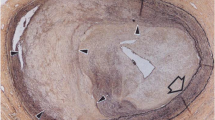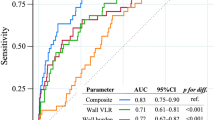Abstract
Purpose The present study evaluates clinical feasibility of cardiac multidetector computed tomography angiography (MDCTA) to detect significant stenosis of coronary vessels due to transplant vasculopathy (TVP) after heart transplantation (HTx). Methods Twenty-eight consecutive male HTx-recipients scheduled for their annual routine conventional coronary angiography (CCA) additionally underwent 64-slice MDCTA. Results Two patients were excluded from further MDCTA analysis. Out of 371 remaining coronary vessel segments evaluable by CCA, MDCTA was able to depict 302 (81.4%) in diagnostic image quality. On a segment based analysis, sensitivity, specificity, diagnostic accuracy (DA), negative predictive value (NPV), and positive predictive value (PPV) for detection of significant stenosis were calculated with 87.5%, 97.3%, 97.0%, 99.7%, and 46.7%, respectively. On a patient-based evaluation, sensitivity, specificity, DA, NPV, PPV were 100%, 81%, 84.6%, 100% and 55.6%, respectively. Evaluation of stenosis degree by MDCTA showed systematic overestimation of 4.4%. A moderate to good agreement comparing both modalities was found (Pearson’s correlation coefficient: 0.64). Conclusion High NPV suggesting 64-slice MDCTA being a reliable diagnostic tool for ruling out significant stenosis due to TVP in HTx patients. But its clinical value in these particular patients needs further investigation.





Similar content being viewed by others
References
Achenbach S (2006) Computed tomography coronary angiography. J Am Coll Cardiol 48:1919–1928
Nikolaou K, Rist C, Wintersperger BJ et al (2006) Clinical value of MDCT in the diagnosis of coronary artery disease in patients with a low pretest likelihood of significant disease. AJR Am J Roentgenol 186:1659–1668
Hosenpud JD, Bennett LE, Keck BM et al (2001) The registry of the international society for heart and lung transplantation: eighteenth official report-2001. J Heart Lung Transplant 20:805–815
Costanzo MR, Naftel DC, Pritzker MR et al (1998) Heart transplant coronary artery disease detected by coronary angiography: a multiinstitutional study of preoperative donor and recipient risk factors. Cardiac transplant research database. J Heart Lung Transplant 17:744–753
Aranda JM Jr, Hill J (2000) Cardiac transplant vasculopathy. Chest 118:1792–1800
Pinney SP, Mancini D (2004) Cardiac allograft vasculopathy: advances in understanding its pathophysiology, prevention, and treatment. Curr Opin Cardiol 19:170–176
Smart FW, Ballantyne CM, Cocanougher B et al (1991) Insensitivity of noninvasive tests to detect coronary artery vasculopathy after heart transplant. Am J Cardiol 67:243–247
Gregory SA, Ferencik M, Achenbach S et al (2006) Comparison of sixty-four-slice multidetector computed tomographic coronary angiography to coronary angiography with intravascular ultrasound for the detection of transplant vasculopathy. Am J Cardiol 98:877–884
Iyengar S, Feldman DS, Cooke GE et al (2006) Detection of coronary artery disease in orthotopic heart transplant recipients with 64-detector row computed tomography angiography. J Heart Lung Transplant 25:1363–1366
Romeo G, Houyel L, Angel CY et al (2005) Coronary stenosis detection by 16-slice computed tomography in heart transplant patients: comparison with conventional angiography and impact on clinical management. J Am Coll Cardiol 45:1826–1831
Sigurdsson G, Carrascosa P, Yamani MH et al (2006) Detection of transplant coronary artery disease using multidetector computed tomography with adaptative multisegment reconstruction. J Am Coll Cardiol 48:772–778
Kuettner A, Kopp AF, Schroeder S et al (2004) Diagnostic accuracy of multidetector computed tomography coronary angiography in patients with angiographically proven coronary artery disease. J Am Coll Cardiol 43:831–839
Leber AW, Knez A, Becker C et al (2003) Non-invasive intravenous coronary angiography using electron beam tomography and multislice computed tomography. Heart 89:633–639
Benza RL, Zoghbi GJ, Tallaj J et al (2004) Palliation of allograft vasculopathy with transluminal angioplasty: a decade of experience. J Am Coll Cardiol 43:1973–1981
Stork S, Behr TM, Birk M et al (2006) Assessment of cardiac allograft vasculopathy late after heart transplantation: when is coronary angiography necessary? J Heart Lung Transplant 25:1103–1108
St Goar FG, Pinto FJ, Alderman EL et al (1992) Intracoronary ultrasound in cardiac transplant recipients. In vivo evidence of “angiographically silent” intimal thickening. Circulation 85:979–987
Dressler FA, Miller LW (1992) Necropsy versus angiography: how accurate is angiography? J Heart Lung Transplant 11:S56–S59
De Geest S, Abraham I, Moons P et al (1998) Late acute rejection and subclinical noncompliance with cyclosporine therapy in heart transplant recipients. J Heart Lung Transplant 17:854–863
Leber AW, Knez A, von Ziegler F et al (2005) Quantification of obstructive and nonobstructive coronary lesions by 64-slice computed tomography: a comparative study with quantitative coronary angiography and intravascular ultrasound. J Am Coll Cardiol 46:147–154
Johnson TR, Nikolaou K, Wintersperger BJ et al (2006) Dual-source CT cardiac imaging: initial experience. Eur Radiol 16:1409–1415
Rybicki FJ, Otero HJ, Steigner ML et al (2008) Initial evaluation of coronary images from 320-detector row computed tomography. Int J Cardiovasc Imaging 24:535–546
Oncel D, Oncel G, Tastan A (2007) Effectiveness of dual-source CT coronary angiography for the evaluation of coronary artery disease in patients with atrial fibrillation: initial experience. Radiology 245:703–711
Leschka S, Scheffel H, Desboilles L et al (2007) Imaging quality and reconstruction intervals of dual-source CT coronary angiography: recommendations for ECG-pulsing windowing. Invest Radiol 42:543–549
Coles DR, Smail MA, Negus IS et al (2006) Comparison of radiation doses from multislice computed tomography coronary angiography and conventional diagnostic angiography. J Am Coll Cardiol 47:1840–1845
Stolzmann P, Scheffel H, Schertler T et al (2008) Radiation dose estimates in dual-source computed tomography coronary angiography. Eur Radiol 18:592–599
Husmann L, Valenta I, Gaemperli O et al (2008) Feasibility of low-dose coronary CT angiography: first experience with prospective ECG-gating. Eur Heart J 29:191–197
Achenbach S, Moselewski F, Ropers D et al (2004) Detection of calcified and noncalcified coronary atherosclerotic plaque by contrast-enhanced, submillimeter multidetector spiral computed tomography: a segment-based comparison with intravascular ultrasound. Circulation 109:14–17
Mahnken AH, Wildberger JE, Sinha AM et al (2003) Value of 3D-volume rendering in the assessment of coronary arteries with retrospectively ECG-gated multislice spiral CT. Acta Radiol 44:302–309
Escaned J, Baptista J, Di Mario C et al (1996) Significance of automated stenosis detection during quantitative angiography. Insights gained from intracoronary ultrasound imaging. Circulation 94:966–972
Swallow RA, Court IA, Calver AL, Curzen NP (2006) The limitations of coronary angiography: identification of a critical coronary stenosis using intravascular ultrasound. Int J Cardiol 106:123–125
Davidson C, Stacul F, McCullough PA et al (2006) Contrast medium use. Am J Cardiol 98:42K–58K
McCullough PA, Adam A, Becker CR et al (2006) Epidemiology and prognostic implications of contrast-induced nephropathy. Am J Cardiol 98:5K–13K
Friedewald VE, Goldfarb S, Laskey WK et al (2007) The editor’s roundtable: contrast-induced nephropathy. Am J Cardiol 100:544–551
Leber AW, Johnson T, Becker A et al (2007) Diagnostic accuracy of dual-source multi-slice CT-coronary angiography in patients with an intermediate pretest likelihood for coronary artery disease. Eur Heart J 28:2354–2360
Author information
Authors and Affiliations
Corresponding author
Rights and permissions
About this article
Cite this article
von Ziegler, F., Leber, A.W., Becker, A. et al. Detection of significant coronary artery stenosis with 64-slice computed tomography in heart transplant recipients: a comparative study with conventional coronary angiography. Int J Cardiovasc Imaging 25, 91–100 (2009). https://doi.org/10.1007/s10554-008-9343-z
Received:
Accepted:
Published:
Issue Date:
DOI: https://doi.org/10.1007/s10554-008-9343-z




